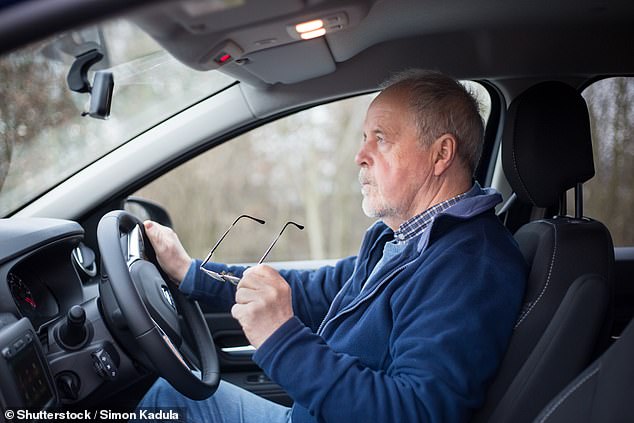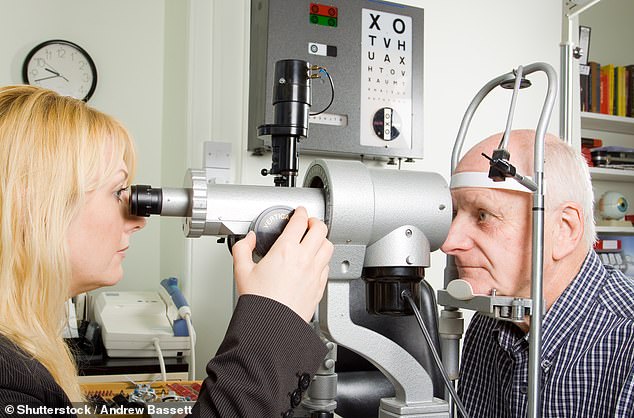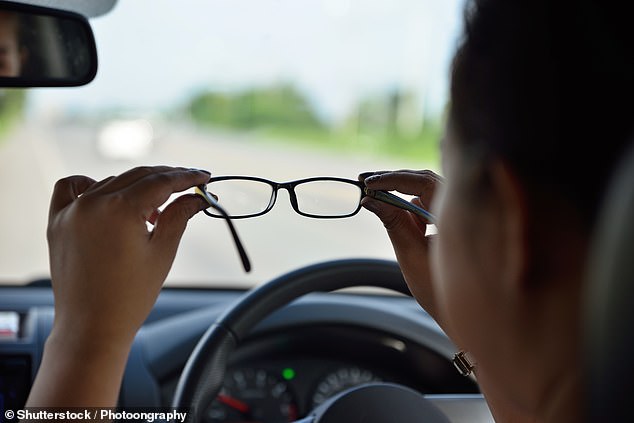Most optometrists say they have seen patients in the last month who are still driving despite being told their vision does not meet the legal standard.
Nearly three in five (56 percent) said they have at least one patient who stays on the road despite poor vision, a sharp increase from two in five in 2019.
Of those, half (51 percent) say they have more than one patient who continues to drive knowing that their vision is so poor that it is considered below the legal requirement.
The investigation comes from the Association of Optometrists (AOP), which wants changes to the law requiring all drivers to undergo an eye test when they apply for a license for the first time, as well as each time they renew it.
For drivers under 70, a renewal is required every 10 years, while for older drivers it is every three years after turning 70.
The results are supported by a public survey that showed that up to one in seven (14 percent) people say they know that a family member, friend or co-worker is driving despite having vision below the legal standard. A quarter (26 per cent) are also concerned that someone they know is driving with vision problems.
Most optometrists say they have seen patients in the last month who are still driving despite being told their vision does not meet the legal standard, a shocking new report reveals.
A third (32 per cent) of 910 optometrists surveyed in the UK said the number of patients they advise not to drive due to vision problems has increased over the past three years.
However, there is a clear reluctance among motorists to give up the freedom of the road.
In a separate survey of 2,081 UK adults, only two-thirds of those with a license said they would stop driving altogether if a test showed their vision had fallen below the legal standard; more than one in 20 (6 percent) would continue driving normally. .
The shocking report follows a series of high-profile convictions where drivers had been told to stop driving by an optometrist or the DVLA.
In one such case, Neil Pemberton, from Lancashire, had been told his vision was extremely poor and he should not drive again in 2013.
He later had an eyesight test in 2016 and was told he had no vision in his right eye and very poor vision in his left eye, but informed the DVLA there was no problem with his sight when he renewed his licence.
Nearly a decade after he was told not to drive, he fatally struck another man crossing the street.
The warning about the number of motorists with poor vision on the roads comes just weeks after police forces across the country carried out a national road safety campaign to carry out eye checks on drivers on the roads.
It was launched coinciding with the delay at the end of October and was extended until November.
‘Operation Dark Night’, supported by the National Police Chiefs’ Council, involved road vision tests and provided advice to drivers to maintain clear vision in different lighting conditions.

Drivers must read the vehicle’s license plate from a distance of 20 meters and in good daylight when taking the practical test. After that, your eyesight may be left uncontrolled for the rest of your driving career unless the DVLA is informed that your vision has deteriorated.
Current eye test for drivers is ‘dangerously outdated’
The Road Traffic Act 1937 states that drivers must be able to read a vehicle’s number plate from 20 meters (or approximately 65 feet) in good daylight.
However, the vision test does not need to be repeated for the rest of a person’s driving career, unless they inform the DVLA that they believe their vision has deteriorated.
The Association of Optometrists maintains that it should not be up to drivers to declare the quality of their vision, especially for older drivers, who are legally required to renew their license every three years.
Two thirds (65 per cent) of professionals believe the DVLA guidance is “dangerously out of date” and more than three in five (63 per cent) believe it puts people at unnecessary risk of harm on the roads of the country. United Kingdom.

The Association of Optometrists wants the law to be changed so that drivers must have their vision checked by a professional every time they renew their license. For those under 70, that’s every 10 years. For older drivers, it is every three years after turning 70.
Adam Sampson, chief executive of the AOP, described the research findings as a “stark reminder of why our UK roads are not as safe as they should be”.
He said: ‘In the UK, the number plate test is not a proper vision test. It is done one time with a driving instructor, not a trained eye health professional.
“A driver’s vision can remain intact for the rest of his life.”
Adam said this approach is “flawed” and “out of step” with many other countries that use a comprehensive visual test to judge whether a person is safe to drive.
“What is deeply concerning is that we have a decade’s worth of evidence to highlight the risks and the growing concern of vision experts,” he continued.
‘Change is never easy. There was enormous opposition to drink-driving laws and mandatory seat belt use, but these interventions save lives.
‘Our surveys show that the majority of the public supports the idea of mandatory regular visual checks for all drivers.
“That is why we are calling on the Department of Transport to update the law to ensure that all drivers must undergo vision screening and this must be done by reliable means.”

One in seven UK adults surveyed by the AOP said they know a family member, friend or co-worker is driving with illegal vision problems. A quarter are also concerned that someone they know is driving with vision problems.
Professor Julie-Anne Little, former president of the AOP and optometrist researcher, said many drivers are unaware that their vision has deteriorated over time and the impact it is having on their driving ability.
“Poor vision has been shown to slow reaction times and the ability to drive safely, and it doesn’t take much for one mistake to lead to a serious collision with catastrophic consequences,” he explained.
‘As an optometrist, I have sometimes had to sit down with a patient to explain that their vision is simply no longer good enough for driving.
“It’s a difficult conversation, but absolutely necessary: to prevent them from putting themselves and others at risk.”
Some links in this article may be affiliate links. If you click on them, we may earn a small commission. That helps us fund This Is Money and keep it free to use. We do not write articles to promote products. We do not allow any commercial relationship to affect our editorial independence.

